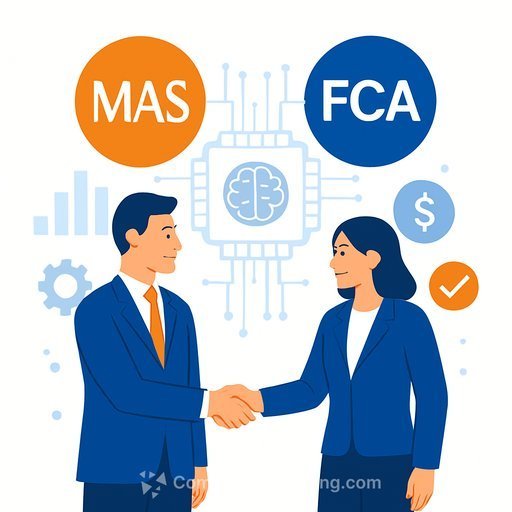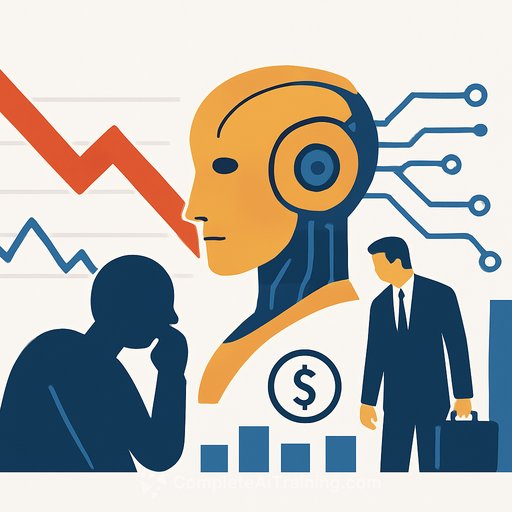AI Rewrites Wall Street: The Dawn of Human-AI Synergy in Stock Trend Spotting
AI analytics has shifted from novelty to core workflow on trading floors. The mix of machine precision and human judgment is now the edge: algorithms scan torrents of data while portfolio managers set context, manage risk, and decide where to place conviction.
The result is faster market responses, tighter decision cycles, and a new skill set for teams that can steer these systems. Those who align process, data, and oversight around AI will set the pace.
The Algorithmic Ascent: What's Changing in Market Dynamics
AI platforms apply machine learning and deep learning across historical prices, volumes, macro data, filings, and real-time news and social sentiment. Patterns that were once invisible become tradable signals with shorter feedback loops.
NLP turns disclosures, headlines, and online chatter into sentiment features that update intraday. In high-frequency settings, this compresses reaction time and reduces room for manual arbitrage.
Industry estimates peg the AI trading market at about $11.2 billion in 2024, with expectations near $33.45 billion by 2030. The direction is clear: more data, lower latency, and models embedded across the order-to-execution stack.
Who's Building the Stack
The path runs from rule-based algos in the 1990s to today's adaptive models. Quant funds and banks lead implementation, while big tech supplies the compute backbone.
Examples include BlackRock (NYSE: BLK) via Aladdin for portfolio and risk, and JPMorgan Chase (NYSE: JPM) through in-house research and deployment. Google (NASDAQ: GOOGL) and Microsoft (NASDAQ: MSFT) anchor the cloud and AI tooling behind many platforms.
Market response has mixed optimism on efficiency with concern over volatility spikes and oversight. The consensus: adopt with controls, explainability, and robust testing.
Winners and Losers: Where Value Accrues
Potential Winners- Quant Hedge Funds and Asset Managers: Firms such as Renaissance Technologies and Two Sigma, with strong data science pipelines, can iterate models faster and expand signal coverage.
- FinTech Innovators: Companies like Palantir Technologies (NYSE: PLTR) that deliver data integration and AI analytics see rising demand from desks seeking end-to-end solutions.
- Cloud and AI Infrastructure Providers: Amazon Web Services (NASDAQ: AMZN), Microsoft Azure (NASDAQ: MSFT), and Google Cloud (NASDAQ: GOOGL) benefit from compute, storage, and MLOps requirements.
- Data Providers: Refinitiv (LSE: LSEG) and S&P Global (NYSE: SPGI) gain as diverse, clean, and timely data becomes the input that sets signal quality.
- Slow-Adopter Brokers and Managers: Teams reliant on manual workflows may see eroding market share and thinner margins.
- Retail Traders Without AI Tools: Competing against institutional signal speed and feature depth becomes harder.
- Legacy Software Vendors: Stacks that cannot integrate modern AI models and data pipelines risk replacement.
Expect higher profitability and multiples for adopters with execution discipline, and consolidation among laggards. Demand for data scientists, ML engineers, and model risk specialists will keep rising across front, middle, and back office.
The Wider Significance: Market Structure and Policy
Prices adjust faster as AI ingests earnings, macro prints, and social signals within milliseconds. That compresses the alpha window and shifts value to better features, cleaner data, and superior model governance.
This cycle creates an arms race for better models and alternative data sources, and elevates the role of vendors as strategic partners. It also increases the need for circuit breakers, kill switches, and surveillance that can keep pace.
Regulators are evaluating model bias, feedback loops, spoofing risk, and opaque decision paths. See the SEC's proposal on predictive data analytics conflicts of interest here, and the Financial Stability Board's report on AI in financial services here.
What Comes Next
Short term, more desks will automate routine analysis and redeploy humans to strategy, client outcomes, and oversight. Expect specialized models by asset class, regime-aware signal routing, and expanded model risk frameworks.
Longer term, more autonomy in trading systems is plausible, with tighter guardrails for accountability. Quantum-enhanced workflows may broaden scenario testing and option pricing, but costs and practicality will dictate timing.
Practical Playbook for Finance Teams
- Data and Features: Build a clean, versioned data layer; track lineage; standardize alt-data onboarding. Measure feature drift and data latency.
- Model Lifecycle: Use MLOps for training, validation, deployment, and rollback. Keep human-in-the-loop for threshold moves and regime shifts.
- Controls and Resilience: Implement kill switches, circuit breakers, and position/venue limits. Stress test for liquidity gaps and message-rate spikes.
- Explainability and Audit: Maintain model cards, feature importance reports, and decision logs. Align with XAI expectations and internal audit needs.
- Compliance by Design: Pre-clear data rights, monitor for manipulation signals, and benchmark against regulatory guidance.
- Talent and Training: Cross-train PMs, quants, and engineers; pair data scientists with risk and compliance for day-two operations.
- Metrics That Matter: Track alpha half-life, slippage, fill quality, signal-to-noise, PnL attribution, and model degradation alerts.
- Cost Discipline: Right-size cloud instances, cache features, and retire dead models to control unit economics.
Signals to Watch
- Performance of AI-driven funds versus traditional peers through different rate and volatility regimes.
- Growth in AI-based research and execution platforms and their adoption across mid-market managers.
- New rules or guidance on explainability, data governance, and trader oversight tied to model use.
Upskilling the Desk
Teams that can read models, question features, and tie outputs to portfolio objectives will outperform tooling alone. For practical resources on AI tools and role-based learning paths, explore AI tools for finance and courses by job.
The Intelligent Investor: Bottom Line
AI is best used as an amplifier of human expertise. Let models handle scale and speed; let people set context, ethics, and strategy.
Assess issuers and managers by how well they integrate AI across data, modeling, execution, and controls. Those with clear governance, measurable uplift, and disciplined rollout are set up for durable advantages.
This content is for informational purposes only and is not financial advice.
Your membership also unlocks:






